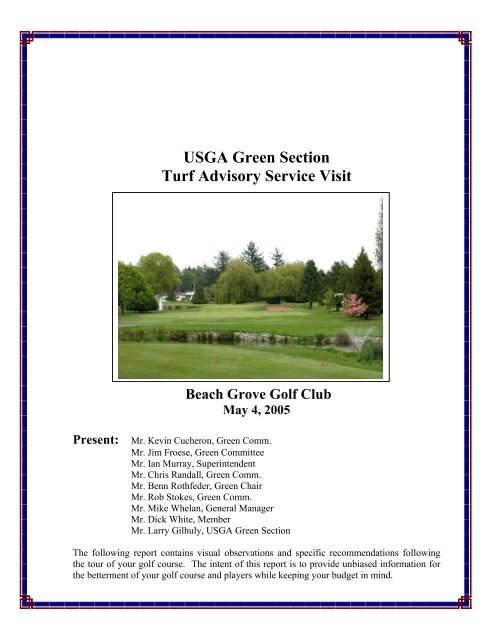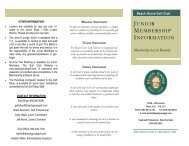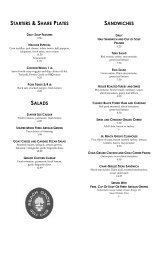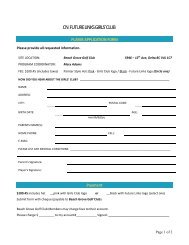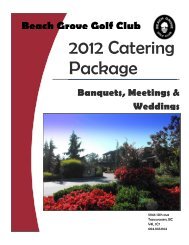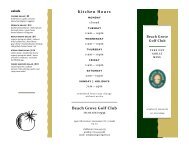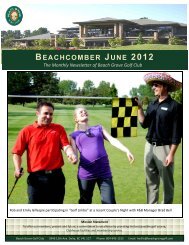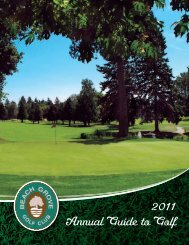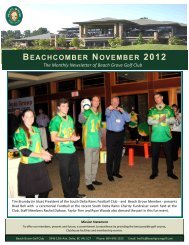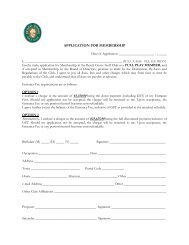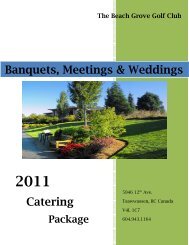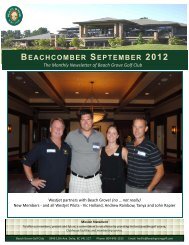USGA Green Section Turf Advisory Service Visit - Beach Grove Golf ...
USGA Green Section Turf Advisory Service Visit - Beach Grove Golf ...
USGA Green Section Turf Advisory Service Visit - Beach Grove Golf ...
You also want an ePaper? Increase the reach of your titles
YUMPU automatically turns print PDFs into web optimized ePapers that Google loves.
<strong>USGA</strong> <strong>Green</strong> <strong>Section</strong><br />
<strong>Turf</strong> <strong>Advisory</strong> <strong>Service</strong> <strong>Visit</strong><br />
<strong>Beach</strong> <strong>Grove</strong> <strong>Golf</strong> Club<br />
May 4, 2005<br />
Present: Mr. Kevin Cucheron, <strong>Green</strong> Comm.<br />
Mr. Jim Froese, <strong>Green</strong> Committee<br />
Mr. Ian Murray, Superintendent<br />
Mr. Chris Randall, <strong>Green</strong> Comm.<br />
Mr. Benn Rothfeder, <strong>Green</strong> Chair<br />
Mr. Rob Stokes, <strong>Green</strong> Comm.<br />
Mr. Mike Whelan, General Manager<br />
Mr. Dick White, Member<br />
Mr. Larry Gilhuly, <strong>USGA</strong> <strong>Green</strong> <strong>Section</strong><br />
The following report contains visual observations and specific recommendations following<br />
the tour of your golf course. The intent of this report is to provide unbiased information for<br />
the betterment of your golf course and players while keeping your budget in mind.
<strong>Beach</strong> <strong>Grove</strong> <strong>Golf</strong> Club -2-<br />
May 4, 2005<br />
It was a pleasure to visit <strong>Beach</strong> <strong>Grove</strong> <strong>Golf</strong> Club on May 4, 2005 on behalf of the <strong>USGA</strong> <strong>Green</strong><br />
<strong>Section</strong> as part of our <strong>Turf</strong> <strong>Advisory</strong> <strong>Service</strong> (TAS). The main purpose of the following TAS report<br />
is to provide an unbiased review of the maintenance operation while offering recommendations to<br />
improve the golf course and maintenance operation within your budgetary limitations. Since the<br />
time of the last visit several years ago it was good to view the completion of the major drainage<br />
effort on the back nine with the new lake and fairway on No. 17. The entire back nine (excluding<br />
Nos. 10 and most of No. 18) are very dry with minimal earthworm problems when compared to the<br />
native soil on the front nine. In addition to the physical improvement on the back nine, the putting<br />
surfaces were in good spring condition, the aprons improved with regular topdressing, aeration and<br />
mowing with triplex mowers and the tees were in good condition due to correct protection during<br />
the winter months. Mr. Murray and his staff deserve a “well done” for the conditioning they are<br />
providing their players based on the cost of golf at <strong>Beach</strong> <strong>Grove</strong> and the very difficult noise<br />
restrictions found around the course!<br />
While these were all positive aspects noted on the golf course, there were still many areas that need<br />
to be addressed that range from costly (maintenance facility and irrigation system) to minor changes<br />
in programs that may actually reduce budget costs. Specific recommendations for several main<br />
topics were discussed including greens, green surrounds, fairways, trees, irrigation system,<br />
maintenance facility and miscellaneous topics. Should you have any further questions please do not<br />
hesitate contacting our office.<br />
GREENS<br />
Observations. The putting surfaces were in very good spring condition despite the normal problem<br />
with Poa annua seedhead development that always leads to afternoon bumpy conditions. <strong>Green</strong><br />
speed has become a major issue and the control of organic material is always a concern when<br />
greens are extended beyond their mowing capabilities. Finally, the greens are currently mowed<br />
with gas powered triplex mowers resulting in more stress on the green perimeters and noise<br />
problems with the neighbors.<br />
Recommendations. The putting surfaces are the “resume” of most golf courses, thus they deserve<br />
the primary focus of attention. During the past decade I have had the opportunity to visit <strong>Beach</strong><br />
<strong>Grove</strong> on several occasions and have always found the fundamental programs conducted by Mr.<br />
Murray to be very sound and providing good playing surfaces during the growing season. At the<br />
same time, it has always been the responsibility of the golf course superintendent to make sure that<br />
desired changes in programs that will cause too much stress should be avoided as turf loss can<br />
occur when weather patterns take a turn for the worse. Based on conversations from those in<br />
attendance, this occurred in 2004 and during the past winter, thus the following was suggested as<br />
you enter the main playing season for 2005:<br />
• Don’t be obsessed with green speed! Mr. Murray mentioned that the goal for green speed has<br />
increased over the years with regular speeds expected during the growing season in the 10’-<br />
10’6” range. While there certainly are those players that prefer these “tournament” conditions,<br />
the focus at <strong>Beach</strong> <strong>Grove</strong> should be on smoothness and taking advantage of as much surface
<strong>Beach</strong> <strong>Grove</strong> <strong>Golf</strong> Club -3-<br />
May 4, 2005<br />
area as possible for hole locations. Please note the enclosed reprint taken from the latest <strong>USGA</strong><br />
<strong>Green</strong> <strong>Section</strong> Record discussing the many non-agronomic factors that should be taken into<br />
account when contemplating further lowering of mowing heights to achieve green speeds that<br />
are in excess of major championship speeds 15-20 years ago.<br />
• Eliminate daily green speed posting. As can<br />
be noted in the enclosed reprint, golfers of all<br />
skill levels have difficulty telling the difference<br />
of 6” at any speed and have increasing difficulty<br />
as green speeds approach 10’ of determining a<br />
1’ difference in speed. The <strong>USGA</strong> Stimpmeter<br />
was designed to give the golf course<br />
superintendent a measuring device for green<br />
consistency, not as a tool to achieve fast greens<br />
or for daily green speed posting as these<br />
numbers mean virtually nothing to the vast<br />
majority of players and offer no aid to those Consistency, yes – daily readings, no!<br />
that play the greens that day. Here are just a few facts that favor the elimination of this practice:<br />
1. To provide a true reading you should test every green, thereby wasting valuable labor.<br />
2. The speed of a green changes during the day from normal growth.<br />
3. The speed of a green changes dramatically during the day, especially when Poa annua<br />
seedheads are forming.<br />
4. The speed of a green changes during the day based on the type of roller used.<br />
5. The practice green is usually 1’ faster than the regular greens due to foot traffic<br />
around the holes. If this is the tested green, it is not a true indicator.<br />
6. Regular hole locations in the green centers are usually faster than perimeter locations<br />
due to foot traffic.<br />
7. The degree of slope dramatically changes the perceived speed of individual greens.<br />
8. Shaded greens are usually a different speed than full sun greens, especially in the<br />
afternoon.<br />
9. Wet sand from topdressing has a major effect on green speed when compared to dry<br />
sand.<br />
10. Daily Stimpmeter readings are generally taken early in the morning on one green.<br />
Which one and what part of the green is the average for all the greens that day<br />
The game of golf is supposed to be a test of skill that requires both physical and mental ability<br />
to adapt to the various challenges the golf course and nature provide. Providing players with<br />
numbers that mean very little based on the time they play only results in negative questioning of<br />
the golf course superintendent when the player may have a bad day on the greens and is a waste<br />
of valuable time that should be spent supervising the staff. Also, note the enclosed reprint on<br />
this topic.<br />
• Do be obsessed with green smoothness! While the obsession with fast greens is generally<br />
driven by those with lower handicaps (usually a small, yet vocal minority at most private clubs),
<strong>Beach</strong> <strong>Grove</strong> <strong>Golf</strong> Club -4-<br />
May 4, 2005<br />
every player appreciates smooth surfaces with<br />
adequate pace (9’-9’6” should be a realistic goal<br />
during the growing season). While Mr. Murray<br />
should not change his basic programs of light<br />
and frequent topdressing using the spin<br />
topdresser, regular vertical mowing (especially<br />
during seedhead time), light and frequent<br />
fertilizer applications, the use of growth<br />
regulation and careful irrigation, one area where<br />
green smoothness can be created is with a fast,<br />
self-contained roller. It was suggested to<br />
demonstrate the unit to the right as seen the day<br />
after this visit at Everett CC where rolling and spiking were being conducted in the same<br />
operation. Newer self-contained “sidewinders” can roll as fast or faster than triplex type units,<br />
thus this is one area where improvement can be made. Also, enclosed is the latest information<br />
on green rolling. Rolling can be completed up to 3 times weekly, however great care must be<br />
taken to avoid rolling during times of excess moisture (all winter and early and late in the<br />
season) and during warm summer temperatures. This is an area that should be under the<br />
complete control of the golf course superintendent based on his experience and weather<br />
patterns. Dictating a strict rolling schedule is not recommended!<br />
The other major difficulty facing Mr. Murray is the difference in growth amount and habit<br />
between creeping bentgrass and Poa annua. As opposed to virtually all of the other older<br />
private clubs in the Lower Mainland, the greens at <strong>Beach</strong> <strong>Grove</strong> are comprised of a high<br />
percentage of creeping bentgrass. While this grass is very smooth and consistent during the<br />
growing season, it does not grow during the winter and becomes grainy. Poa annua, on the<br />
other hand, grows all winter long, has little grain and develops seedheads in the spring. These<br />
differing growth rates result in bumpier surfaces during the winter months, however achieving<br />
smooth surfaces during the winter is very difficult since rolling should be avoided due to wet or<br />
frozen conditions, topdressing generally is not completed and vertical mowing can only be done<br />
with great care. Bottom line – do not try to “push” the greens at <strong>Beach</strong> <strong>Grove</strong> in the winter.<br />
Take a conservative approach of protecting the greens as you have done in the past so the<br />
majority of the membership can enjoy smoother and healthier surfaces during the growing and<br />
regular playing season.<br />
• Experiment with A4 overseeding on one green. While creeping bentgrass and Poa annua<br />
have different growth characteristics, newer varieties of bentgrass are far less grainy and display<br />
a similar density to most Poa annua. With this in mind it was suggested to select one green for<br />
overseeding with A4 at a rate of ½ lb./M during June, July and August following spiking<br />
efforts. With the natural ability to resist anthracnose and pink snow mold while germinating<br />
and surviving under low mowing heights, this could prove to be a valuable experiment.<br />
• Control seedheads when Proxy becomes available. For several years golf course<br />
superintendents in the U.S. have had the growth regulator Primo at their disposal, thereby<br />
allowing for faster and smoother greens during the growing season. This product is now
<strong>Beach</strong> <strong>Grove</strong> <strong>Golf</strong> Club -5-<br />
May 4, 2005<br />
commonly used throughout Canada (and at<br />
<strong>Beach</strong> <strong>Grove</strong>), however a second growth<br />
regulator (Proxy) that virtually stops Poa annua<br />
seedhead development has not been introduced<br />
into Canada at this time. When it becomes<br />
available, its’ use during the spring will greatly<br />
reduce complaints about green speed and<br />
smoothness as has occurred throughout the U.S.<br />
• Increase aeration using smaller tines and an<br />
upgraded aeration unit. While green aeration<br />
is never appreciated by golfers or the<br />
maintenance staff, recent changes in aeration<br />
options has greatly reduced the negative nature<br />
of this operation. In regard to the aeration<br />
program, it was suggested to demonstrate the<br />
new Toro Procore 640 (shown in the photo to<br />
the right) to improve this important portion of<br />
the operation. This walking aerifier offers<br />
excellent versatility by allowing the operator to<br />
change spacing and depth (if desired) with a<br />
simple flip of a switch. In addition, this single<br />
unit is as fast as two other walking units combined and the tires on this unit are set to avoid<br />
smashing aeration holes that have previously been made. In short, if this unit provides the<br />
expected results of clean holes with tighter spacing you will be able to reduce the size of the<br />
tines down to ½” and recover from future aeration operations at least twice as fast as larger tine<br />
usage. For example, during a visit to Everett CC the day after visiting <strong>Beach</strong> <strong>Grove</strong> all of the<br />
members in attendance stated that the aeration was not a major disruption this year with good<br />
putting conditions within 7 days of the aeration with this new unit. Some even claimed that the<br />
conditions weren’t that bad after only 2-3 days! This unit (or similar) would be a major tool in<br />
the control of organic on your greens.<br />
• Demonstrate a new type of green spiker. In<br />
addition to upgrading the regular aeration<br />
equipment used for the greens, a very rapid and<br />
deep method of green spiking has been<br />
introduced with the Planet Air unit shown to the<br />
right. This unit offers a fast and labor efficient<br />
method to spike the greens to a depth of 3” (note<br />
photo at top of next page) with minimal surface<br />
disruption while creating results similar to<br />
regular tine aeration without organic matter<br />
removal. Monthly spiking with this type of unit<br />
followed by light sand topdressing during the<br />
growing season has proven very beneficial in other portions of the country, with exceptional
<strong>Beach</strong> <strong>Grove</strong> <strong>Golf</strong> Club -6-<br />
May 4, 2005<br />
results reported in Southern California. With the program of regular light topdressing greatly<br />
reducing the negative impact of organic accumulation and the addition of a new type of green<br />
aerifier that will remove more organic with smaller tine size, it is possible that this unit could<br />
reduce regular green aeration to only one time yearly if used in a regular monthly program of<br />
spiking and topdressing. This operation was viewed at Point Grey CC before this visit with<br />
outstanding results completing all 19 greens in less than 4 hours. You may wish to have this<br />
unit demonstrated or have the greens contractually sliced/aerified during the early summer to<br />
determine if it fits in your operation and is acceptable with your membership.<br />
• Demonstrate both walking and triplex electric<br />
mowers. The problem with noise restrictions<br />
severely impacts the efficiency of the<br />
maintenance staff at <strong>Beach</strong> <strong>Grove</strong> with no work<br />
allowed before 7:00 AM during the week, 9:00<br />
AM on Saturdays and no noise on Sundays. As<br />
with every golf course, <strong>Beach</strong> <strong>Grove</strong> receives<br />
comparisons, however this is one area that sets<br />
your course apart (in a negative way) that simply<br />
can not be overcome since the noise abatements<br />
also apply to the evening hours. One possible<br />
way to improve the situation is the use of new<br />
walking electric mowers that were recently viewed at Pebble <strong>Beach</strong>. The response has been<br />
very favorable at this well-known course, thus it was suggested to demonstrate these units for<br />
<strong>Beach</strong> <strong>Grove</strong>. If these walking mowers address the noise issue, then a conversion to all electric<br />
walking mowers should occur as soon as possible to improve overall staff efficiency. The use<br />
of walking mowers would also fit nicely into the concept of section maintenance.<br />
• Give serious consideration to section maintenance. The main advantage of this type of<br />
maintenance during the growing season is the ability to motivate the staff by having 5-6<br />
individuals “owning” certain portions of the golf course. The addition of walking green<br />
mowers, walking tee mowers (if desired) and hand raking bunkers (if desired) combined with<br />
regular bunker edging, divot repair on the tees and other housekeeping details would enhance<br />
playing quality on these key areas while greatly minimizing transportation time associated with<br />
these individual operations. Please note the enclosed reprint that describes this topic in greater<br />
detail for possible use at your course during the week in the summer months. This form of<br />
maintenance may also be less noisy than multiple vehicles across the course in the early hours.<br />
GREEN SURROUNDS<br />
Observations. The areas that surround the greens (collars, aprons, bunkers and roughs) are the<br />
second most important portion of every golf course. The collars displayed minor “collar dams”, the<br />
aprons have improved significantly with increased aeration and topdressing, the bunkers are<br />
relatively contaminated with fine material and the traffic areas are still in recovery from winter<br />
traffic issues on some holes.
<strong>Beach</strong> <strong>Grove</strong> <strong>Golf</strong> Club -7-<br />
May 4, 2005<br />
Recommendations. Specific recommendations for the green surrounds included the following:<br />
• Address collar dams using either the “Fircrest” or “Glendale” approach. The existence of<br />
collar dams can be noted on nearly every green at <strong>Beach</strong> <strong>Grove</strong> due to regular sand applications<br />
and dragging resulting in more sand placed on the collars than on the outer edge of the greens.<br />
This very common problem is noted at virtually every older golf course in the U.S., unless<br />
regular aeration occurs on the collars on the same day as the greens. Mr. Murray mentioned<br />
that this is exactly what has been done at <strong>Beach</strong> <strong>Grove</strong> for many years, however the collar dams<br />
still exist resulting in water not flowing immediately off the fronts of the greens and “reverse”<br />
contours where well hit shots can “skip” across the surface rather than react like normal shots.<br />
For this reason, it was suggested to either use the strip and resod method used at Glendale and<br />
Tacoma CC during the past two years or the slower “Fircrest” method of aeration 3-4 times<br />
yearly without topdressing and a vibratory compactor to physically move the soil lower on the<br />
collars. Both techniques are producing good results and can improve this slow change of<br />
contours at <strong>Beach</strong> <strong>Grove</strong>.<br />
• Expand the positive program on the aprons<br />
out as far as the budget will allow. One of the<br />
major problems noted on the front nine fairways<br />
is the high population of earthworms in your<br />
very healthy soil. The exact opposite was noted<br />
on the back nine where the sand based fairways<br />
are virtually clean from earthworms as they<br />
avoid the abrasiveness of the sand. While the<br />
aprons on the course are not all comprised of<br />
sand, they are literally free of earthworms, thus<br />
the obvious question is, “How can these areas be<br />
so clean and comprised of so much bentgrass” The answer is found in three key programs that<br />
have been practiced for many years that should be expanded out to 100 yards from every green,<br />
if possible. First, regular aeration and sand topdressing (especially light topdressing at the same<br />
time as the greens) adds the sand component to the surface. The second program has been the<br />
use of triplex mowers with baskets to remove the food (grass clippings) source for earthworms<br />
while greatly reducing the Poa annua seedheads deposited that compete with bentgrass.<br />
Finally, pink snow mold is a major problem on Poa annua and needs to be controlled on the<br />
aprons to assure complete coverage in these important locations. All three of these programs<br />
have led to a major improvement in turf quality that can be expanded in the same manner<br />
further away from the greens, as shown in the above photo taken on No. 18. The earthworms<br />
don’t stop at the road because of this hard surface. They stop due to the proper programs<br />
conducted by Mr. Murray over the past several years.<br />
• Create a more effective communication tool for the bunkers. There is virtually no golf<br />
course in the Pacific Northwest that does not occasionally have players complain about the<br />
“consistency” of their bunkers! These hazards require nearly as much maintenance as greens<br />
while being driven by the expectation levels of players. To assist the maintenance staff, it was<br />
suggested to create a small form for players to pinpoint exactly what portion of an individual
<strong>Beach</strong> <strong>Grove</strong> <strong>Golf</strong> Club -8-<br />
May 4, 2005<br />
bunker is a concern as you can expect new sand to create initial soft conditions and areas to<br />
become thin. If this form is available at the Pro Shop, a rapid method of communication can be<br />
created to address areas that may be a problem.<br />
• Address traffic areas with more aeration and<br />
topdressing. It was not surprising to learn that<br />
some of the regular winter players at <strong>Beach</strong><br />
<strong>Grove</strong> believe that they could not possibly cause<br />
any problem with turf loss from winter play on<br />
grass that is not growing and is subject to<br />
compaction in high traffic areas. A large<br />
volume of research shows the exact opposite<br />
with the right side of No. 14 green showing the<br />
classic signs of winter turf damage associated<br />
with foot traffic, excess water and a soil that<br />
became sealed causing turf loss. While reducing<br />
play from the greens during all frost, frozen and<br />
saturated conditions should absolutely be<br />
practiced and backed up by the <strong>Green</strong><br />
Committee and Board of Directors in your<br />
maintenance standards, programs can also be<br />
started to improve these locations to minimize<br />
traffic damage. In addition to aeration at least<br />
twice yearly, include the traffic zones in the<br />
same program as green topdressing on a 2-3<br />
week schedule during the growing season. Also,<br />
the use of perennial ryegrass introduces a more wear resistant turf to these locations.<br />
FAIRWAYS<br />
Observations. As mentioned earlier, the main topic for the fairways is the high population of<br />
earthworms on the front nine holes. Other than this issue, drainage is a major requirement on the<br />
front nine and a change in the method of fertilization was discussed as you begin a program of<br />
growth regulation this growing season. Finally, deep aeration, overseeding and topdressing will be<br />
conducted this spring to improve overall turf density on the front nine.<br />
Recommendations. Specific recommendations for the fairways included the following:<br />
• Use Primo on all of the fairways to improve density, reduce clippings and minimize<br />
mowing requirements. It was mentioned that a decision must be made between completing<br />
the deep aeration program in the fall (with overseeding and topdressing) or expanding the use of<br />
Primo to all of the fairways during the growing season. Based on the noise situation and worm<br />
issues, it was recommended to focus on Primo usage this year (along with sand topdressing on<br />
the front nine) and the contractual aeration and seeding this spring only.
<strong>Beach</strong> <strong>Grove</strong> <strong>Golf</strong> Club -9-<br />
May 4, 2005<br />
• Upgrade the ability to apply Primo and liquid<br />
fertilizer with a mixing tank and<br />
proportioner. During several visits last year a<br />
very unique combination of an 1100 gal. holding<br />
tank and material proportioner were viewed at<br />
Eugene CC, Heron Lakes, Eastmoreland and<br />
Waverley CC. The combination of this tank<br />
and proportioner allows for very rapid mixing of<br />
elemental fertilizer with your Primo<br />
applications. Based on personal experience and<br />
observations during the past 30 years, the ability<br />
to further upgrade the mixing procedure will allow for the use of lower priced materials to be<br />
used without the time it normally takes to apply liquids to fairways and larger turf areas. For<br />
more information concerning the holding tank and proportioner contact DPI Supply at 541-928-<br />
4732.<br />
• Demonstrate a faster way to install drainage.<br />
It was suggested to add in-ground drainage inhouse<br />
by upgrading your trencher to an AFT 45<br />
unit. This trencher (note photo) includes a<br />
conveyer belt that can allow two workers to<br />
rapidly complete the amount of work normally<br />
requiring 4-5 employees. Marine Drive has had<br />
excellent results for the past 5 years, thus you<br />
may wish to view this unit at their site prior to<br />
possible purchase for <strong>Beach</strong> <strong>Grove</strong>.<br />
• Expand the apron programs, but do not do all of the fairways. While expanding the<br />
programs on the aprons makes sense for areas that require turf coverage, the cost of the extra<br />
sand, fungicides, clippings removal/storage would be prohibitive. In addition, the extra time<br />
required to complete these operations is not available due to noise restrictions and the current<br />
size of the staff. Focus on the use of Primo and sand topdressing as this combination will<br />
achieve the goal of denser turf with less earthworms at a reasonable cost.<br />
TREES<br />
Observations and recommendations. While minor improvements have been made in this area,<br />
many of the same trees suggested for removal are still in existence with one change – they have all<br />
grown! Specific trees viewed during this tour of the golf course that were suggested for movement<br />
or removal included the following:<br />
• No. 2 green. A large spruce is found to the back left of this green that blocks valuable sunlight<br />
on one of the first greens on the golf course during the winter months. Take a close look at this<br />
tree (and others) from October-December for selective removal to the south side of this green.
<strong>Beach</strong> <strong>Grove</strong> <strong>Golf</strong> Club -10-<br />
May 4, 2005<br />
• No. 8 fairway. While the selective removal of<br />
the large cottonwoods has slowly occurred, the<br />
sequoias selected as the replacement trees offer a<br />
completely different growth habit and size that<br />
must be carefully considered when planted. The<br />
tree on the left side should be moved back over<br />
the cart path to the left as it will inevitably be<br />
removed in the future as it will become<br />
extremely wide and block the entire left side of<br />
the fairway. This tree should be moved next<br />
winter using a large tree spade to assure<br />
survival.<br />
• No. 8 lake. Mr. White correctly mentioned that<br />
a rules issue exists with the two trees near the<br />
lake that should be removed. Any ball hit into<br />
these trees can not be assumed to have gone in<br />
the lake without clear evidence, thus the ball is<br />
lost. In addition, the removal of these two trees<br />
will provide a much clearer view of the green<br />
and water feature on the right.<br />
• No. 10 left side of dogleg near lake. As with<br />
the two trees on No. 8, three similar types of<br />
trees stop shots from entering the lake on this<br />
hole. For the same reason as No. 8, these trees<br />
should either be removed now or moved to<br />
another location on the golf course this winter.<br />
• No. 17 alder replacement tree. Mr. Murray<br />
mentioned that the tree used to replace the key<br />
leaning alder on this new green site is an oak. It<br />
was suggested to possibly move this tree further<br />
to the right (looking at the green) if the width of the tree will be beyond the current width of the<br />
alder.<br />
IRRIGATION SYSTEM<br />
Observations and recommendations. While the irrigation system was not in use at this time, it<br />
has been a major area of discussion in the past. Just as the removal of water is a key to allow for<br />
turf survival and improved playing conditions during the winter and spring months, the irrigation<br />
system represents the survival of the turf during the summer months that leads into the fall playing<br />
season. It was mentioned that the new holes have been fit with a modern system of lines and<br />
controllers, however the remainder of the golf course is easily one of the worst nightmares any golf
<strong>Beach</strong> <strong>Grove</strong> <strong>Golf</strong> Club -11-<br />
May 4, 2005<br />
course superintendent could ever face! The combination of the lack of control, poor spacing, small<br />
pipe size, and system age make <strong>Beach</strong> <strong>Grove</strong> the only older Lower Mainland golf course that has<br />
not upgraded their irrigation system in the last 5-10 years. It was suggested to have a qualified<br />
irrigation designer provide an analysis of the irrigation system to start the process of upgrading one<br />
of the foundations of success for your turf maintenance programs.<br />
MAINTENANCE FACILITY<br />
Observations and recommendations. With the construction of the new maintenance facility at<br />
Quilchena G&CC, <strong>Beach</strong> <strong>Grove</strong> has now taken over the title of “Worst Maintenance Facility” of all<br />
the older private clubs in the Greater Vancouver area. During the past decade Shaughnessy,<br />
Capilano, Seymour, Marine Drive, Point Grey, Vancouver, Richmond and Quilchena have all<br />
completely modernized or greatly upgraded their maintenance facilities to improve working<br />
conditions for their maintenance staff and protect the massive investments made in turf equipment.<br />
As with the irrigation system, this represents a considerable amount of funding, however it must be<br />
addressed as soon as possible as a very high priority. Mr. Rothfeder said it best when he mentioned<br />
that the entire facility could be shut down tomorrow with various code violations. For this reason it<br />
was good to learn that preliminary work is being done in this area.<br />
MISCELLANEOUS TOPICS<br />
Should the practice facility be moved back to<br />
address safety concerns The practice facility at<br />
<strong>Beach</strong> <strong>Grove</strong> is very similar to many older private<br />
golf clubs in the Pacific Northwest as practicing on<br />
your game was seldom done in the early portion of<br />
the 20 th century through the mid-1900’s.. Since the<br />
game has grown and practice is a major part of<br />
improving your swing, the lack of acreage provided<br />
for practice has resulted in the need for high nets<br />
and posts to protect players on adjoining holes.<br />
Excluding the complete elimination of woods, the only other reasonable method to reduce the<br />
safety issue at <strong>Beach</strong> <strong>Grove</strong> is the use of lower compression golf balls. At this time the amount of<br />
golf courses using these golf balls are too numerous to mention, however they do include Overlake<br />
CC, Everett CC, Rainier CC, Fircrest GC, Royal Colwood GC, Point Grey CC, Coeur d”Alene<br />
Resort and Mauna Kea. Enclosed with this report is a reprint describing the exact issue facing<br />
<strong>Beach</strong> <strong>Grove</strong> as these balls offer a simple solution to your safety situation. If this proves<br />
ineffective, then the use of a qualified golf course architect to expand the tee to the rear along with<br />
nets and posts may be the final answer for safety concerns.<br />
Gravel or asphalt – which is best for <strong>Beach</strong> <strong>Grove</strong> While it is true that gravel has less bounce<br />
than asphalt, the many positives of a permanent surface far outweigh this one negative. If you are<br />
concerned about the negative impact of asphalt in areas of play, consider the enclosed reprint.
<strong>Beach</strong> <strong>Grove</strong> <strong>Golf</strong> Club -12-<br />
May 4, 2005<br />
Thank you for the opportunity to discuss your maintenance operation with you as part of the <strong>USGA</strong><br />
<strong>Green</strong> <strong>Section</strong> <strong>Turf</strong> <strong>Advisory</strong> <strong>Service</strong> visit. In addition to this visit and report, please do not<br />
hesitate contacting our office at any time during the year with further questions as they relate to<br />
your golf course or turfgrass in general. Your support of the <strong>USGA</strong> <strong>Green</strong> <strong>Section</strong> is appreciated<br />
and we look forward to being of service on an annual basis as part of your normal golf course<br />
maintenance operation and budget.<br />
Respectfully submitted;<br />
Larry Gilhuly, Northwest Director<br />
<strong>USGA</strong> <strong>Green</strong> <strong>Section</strong><br />
Distribution:<br />
O: Mr. Ian Murray, Superintendent<br />
cc: Mr. George Harvie, President<br />
cc: Mr. Benn Rothfeder, <strong>Green</strong> Chairman<br />
cc: Mr. Mike Whelan, General Manager<br />
Reprints:<br />
- Where Is <strong>Green</strong> Speed Taking the Game<br />
- <strong>Golf</strong>ers Perception of <strong>Green</strong> Speeds Vary<br />
- Say No to Posting<br />
- More Light on Lightweight Rolling<br />
- Walking <strong>Green</strong> Mowers: Solution or Problem<br />
- <strong>Section</strong> Maintenance – It Could Be Your Pot of Gold<br />
- Limited Flight Might Be Your Answer<br />
- Putting the Horse In Front of the Cart<br />
- Growing, Growing, Gone!


